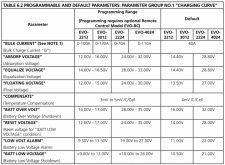I've really come to appreciate Samlex, their engineering & design. They simply don't furtle around with their business. They are doing final tests now on a 48V Stackable inverter series that should kick butt in the sector.... hehe.. can't say more than that I'm afraid.
I'm not familiar with your model, but if you have the RC Remote you can program it and change the profiles. I strongly recommend you find out what firmware revision your system has and ask to get the latest updates from the Samlex Tech guys in Vancouver. If you do not have the RC-Plus remote, I'd suggest you might consider buying one, as you said you've had yours for a while.
Intelligent remote control with LCD display and SD card slot to log data, monitor performance and set parameters on the 2200 - 4000W EVO Inverter/Chargers.

samlexamerica.com
Your 100AH batteries will take a max of 50A / .5C charge rate ea.(Standard ESS LFP battery) In parallel, they can split 100A incoming.
The batteries will not take more amps than they need, the BMS will also limit the maximum current allowable.
The inverter will provide Pass-Through while charging from "shore" power on the 120V side of course.
For powering your 12V loads and observing that directly, I'd suggest using a BUS system using a DC shunt between the battery posts & your 12V distribution. There are several "SmartShunts" available that can communicate via ModBus, CanBus, RS232/485, BlueTooth & Wifi.
Victron Smartshunts are very good.
I do understand that you do not want to overcharge the batteries via the Samlex, but it reads the current being taken by the battery bank, and if 10A of that current is going to service your loads, it won't know that, so it will push that "deficit" and that's OK. When the batteries themselves start reaching 95% they will reduce the amps being taken as expected. So let's say the batts are down to taking 5A, your load is 10A, so total being provided will be 15A by the charger. Now batts reach 100% and take <1A, + load is 10A, the inverter will provide that "11A" but no more and the BMS' will limit it on the batt side to just what they want to top off & balance. The BMS is the Guard Dog & Babysitter too.
Your charger side can be programmed to push up to 100A, like mine which I set to 80A, which I feed from a Generator L5:30 outlet. Trick there is you have to be certain the EVO get's a lot of airflow to manage the heat it generates at the higher amperages. Again, even if you have it set to 100A, the two batts will divide that, the BMS will protect from overload and teh cells will actually control how much they will take - Resistance & Impedance still matter. Absorb Time & Absorb Exit Amps play a very important role here, Exit Amps is calculated as 0.05C, so for 100AH that would be 5A.
With the latest Firmware update, RC-Plus & Manual you can program it up. I myself do NOT use the Lithium Mode, my settings are a bit different because of my setup, see my "About my system" page for more info on that.
Hope it helps, Good Luck.





